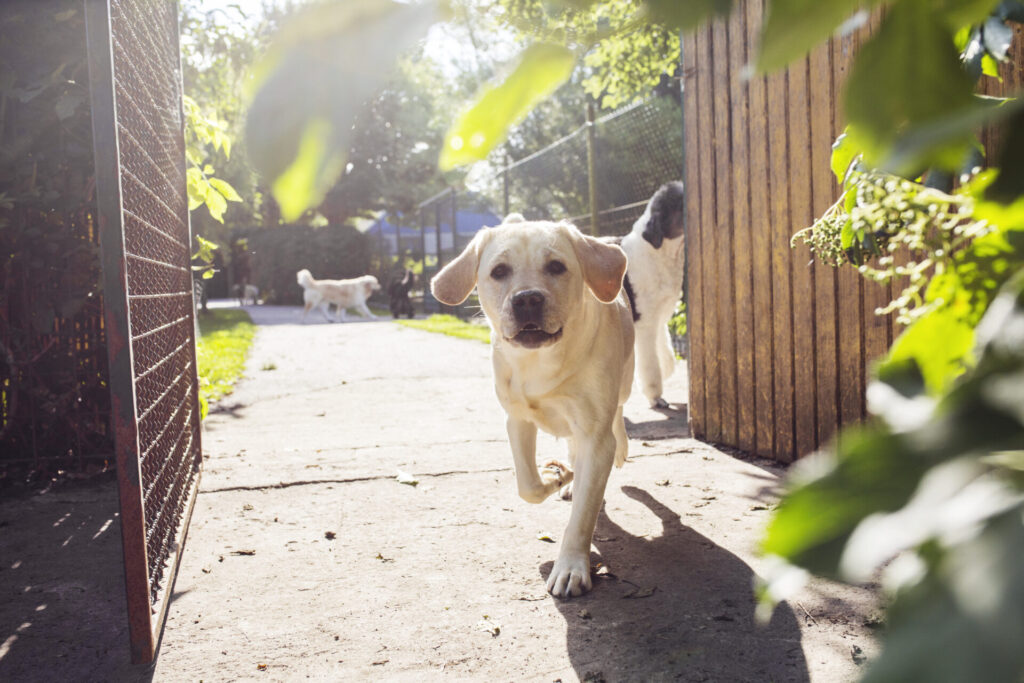The recovery process after dog knee surgery will often determine how successful the surgery is. This means that the owner takes an active role to ensure that all portions of postoperative protocol are followed to ensure the highest success rate.
Walking a dog after surgery will involve slow incremental changes to frequency, duration, and challenge. The first two to three days are a time when the risk of infection, swelling, and bruising are at their highest, and your dog will need to be monitored very closely. Slowly but surely your dog will regain mobility for walks, but during the first six weeks post- op very strict walking protocol will need to be followed.
This article breaks down what to expect from walking your dog post surgery in a hypothetical chronological way throughout the initial six weeks.
Dog Walking Post Surgery Day 1-3
If you have decided to go through with ACL surgery for your dog, then most likely you will have already created a confinement space or a recovery room. The first few days are critical for your dog’s full recovery, and will be imperative that you monitor the incision wound, regularly apply cold compresses, and ensure that the dog is not licking or otherwise rubbing this point on their body.
ad#topbanner
Walks during this phase will simply be to go outside to potty, and absolutely nothing else. This might be somewhere between 4-6 times a day. If there are stairs involved then you can create a harness for your dog. Place a long towel under its belly and lift them up over stairs, to relieve any undue strain on either the injured or non injured hind leg.
Other than short, closely monitored trips outside to go potty, your dog will need to be in a confined space, with no slip floors, or furniture that can be jumped on to.
These first few days are intense for both owner and dog, so be sure there is someone at home with your dog at all times.
Dog Walking Post Surgery: Day 4-14
You may be able to slightly increase the length of walks to about half a block, keep your dog on a short leash at all times, and monitor the healthy hind leg to ensure that it is not bearing too much weight.
You may be able to take this half block walk about 2-3 times daily for the time period leading up to the two week mark. Continue to confine your dog at home, monitor the incision point, and check in with your veterinarian if there is anything concerning to you with how your dog is healing.
Dog Walking Post Surgery: After The Incision Stitches Have Been Removed: Week 2-4
A huge turning point for both owner and dog is when the sutures are removed and the incision wound begins to heal. At this point you may be able to increase walks to a full block, or perhaps a little longer two to three times daily.
ad#topbanner
Be mindful that your dog is always on a leash and will not be tempted to run or play with other dogs. Your dog’s condition is still delicate at this point and you will want to make sure that you continue to monitor their progress and be very gentle with all walks.
Once the sutures are removed, and if you have a pool, it will feel nice for your dog to get in the water where there is no weight bearing on any of the legs and simply move their limbs around with your supervision. If not, keep the walks short and sweet.
Dog Walking Post Surgery: Week 4-6
Begin to increase the length of walks to no more than five to ten minutes, monitor closely the uninjured hind leg to ensure that it is not overly compensating for the injured one.
Continue to keep your dog on a leash, and walk slowly, there should not be any running at this point. Once you reach the six week point, after consulting with your veterinarian, perhaps a gentle trot could be introduced.
Continue to ensure that your dog is getting plenty of rest and healthy nutrition.
Dog Walking Post Surgery: Week 6 and Beyond
The primary objective during this phase is to increase the duration, rather than the intensity or speed of walks. This means longer, not faster walks. Continue to be mindful that your dog remains on a leash until at least week 12 post-surgery.
As walks increase in length, muscle will begin to rebuild around the injured and non-injured hind legs. After consulting with your veterinarian, it is possible by week 12 that your dog may be able to begin experimenting with leash free time. Be sure to monitor your dog closely, and allow their first time off the leash to be alone so they are not jumping and playing too roughly with other dogs.
A Guide To Walking Your Dog Post Surgery: Always Consult With A Professional
This article serves as a general guide to how you, the owner, should handle walking your dog after surgery. If at any time the incision point becomes infected, or the uninjured hind leg demonstrates signs of strain, consult a professional.
The key to walking your dog post knee surgery is to start off slow and short, gradually build up in duration before intensity, and keep your dog on a leash!

